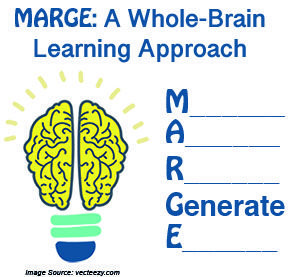Memory
Lifelong Learning and Active Brains: G is for Generate
To improve your memory, tell someone what you've learned!
Posted August 25, 2018

Think it, say it, teach it! These are the simplest things to do to improve your memory. Have you read an interesting news item lately? Listened to a fascinating podcast? Tell someone what you've just learned. Not only will you be engaging in healthy social interchange, you'll remember the information better yourself! Do you want to remember the name of someone you just met? Say the name aloud—"It's a pleasure to meet you Jim"—and it will stick better in your memory. This is the generation effect and it can improve your memory by 30 to 40 percent.

Generate is the fourth principle of MARGE, our whole-brain learning approach, and if you've been reading my previous blogs, I hope you can generate the other four principles using the acronym. The figure on the left illustrates the neural changes that brain scientists suggest occurs during memory consolidation, the process by which long-lasting memories are created. Initial learning requires 1) prefrontal cortex (PFC) activation of pertinent information in the posterior cortex (red nodes in figure) and 2) medial temporal lobe (MTL) bindings that link the information as a stored unit (yellow lines). Through repeated usage and re-activation of the information, memory consolidation occurs, which establishes new information into knowledge networks distributed widely in the cerebral cortex (purple links). The key to long-lasting memories is to re-activate pertinent information after initial learning.
When we generate information—think it, say it, teach it—we automatically re-activate learned information and more importantly connect that information to existing knowledge. Neuroimaging findings have shown that broad cortical networks are activated during the self-generation of information and that this activation leads to better memory. Other terms, such as retrieval practice and production effect have been used to characterize the generate principle. The essential factor is the thoughtful self-generation of information. Don't just restate or repeat what you've learned—say it in your own words. Many students spend hours rereading textbook material and dousing pages with highlighter ink. Such practices have extremely low utility as they prevent the active self-generation of information. Closing the textbook and retrieving the information from memory can more than double your retention compared to rereading or highlighting material.
The more often you self-generate material the better it will be established as a long-lasting memory. Find as many friends as you can who will listen to you and tell them about what you've learned! Students should space their retrieval practice across days. A rule of thumb is to divide your total study time into fifths and test yourself at each time point. For example, if you have 10 days until exam time, try to practice retrieval at an interval of every two days. If you need to retain the information longer (e.g., until a final exam), work to increase the interval between retrieval practice sessions. Useful ways to self-generate information is to apply the 3 C's (categorize, compare, contrast), ask yourself elaborative-interrogation questions ("why" and "how" questions), and draw schematic organizations from memory (hierarchical outlines, concept maps) (see previous blog).
Whenever we relate information to others, we are essentially teaching, and as the noted science fiction author Robert A. Heinlein once said, "when one teaches, two learn." Indeed, teaching is one of the best ways to retain conceptual knowledge as you must reactivate learned information and organize it in your head before you relate it to others. Whether formally to a group or just casually chatting with others, you should be encouraged to teach and tell others what you know. If you feel ambitious, you can even set up a blog and write about a favorite topic. In this way, you are encouraged (as I've been) to regularly disseminate your knowledge—and regardless of whether you garner any followers, you've improved your own memory for the information! Students should be encouraged to participate in study groups and teach each other the material. In this way, they work together to practice generating course information.
Outside the classroom, we basically generate information whenever we encounter it again. That is why the conceptual knowledge we encounter frequently, such as things we need to know in the workplace, are well established. During my career as a memory researcher, I'm sure I've encountered the terms memory consolidation and prefrontal cortex many thousands of times. Such concepts are well integrated in my cortex. So, to retain your conceptual knowledge you must work to re-activate it—use it or lose it.

References
Dunlosky J., Rawson, K. A., Marsh, E. J., Nathan, M. J., Willingham, D. T. (2013). Improving students’ learning with effective learning techniques: Promising directions from cognitive and educational psychology. Psychological Science in the Public Interest 14, 4–58.
Karpicke, J. D., & Roediger, H. L., III. (2008). The critical importance of retrieval for learning. Science, 319, 966–968.
Pashler, H., Bain, P., Bottge, B., Graesser, A., Koedinger, K., McDaniel, M., & Metcalfe, J. (2007). Organizing Instruction and Study to Improve Student Learning (NCER 2007–2004). Washington, DC: National Center for Education Research, Institute of Education Sciences, U.S. Department of Education.
Rosner, Z. A., Elman, J. A. & Shimamura, A. P. (2013). The generation effect: Activating broad neural circuits during memory encoding. Cortex, 49, 1901-1909.


